Related Research Articles

Condottieri were Italian captains in command of mercenary companies during the Middle Ages and multinational armies during the early modern period. They notably served European monarchs and Popes during the Italian Wars of the Renaissance and the European Wars of Religion. Notable condottieri include Prospero Colonna, Giovanni dalle Bande Nere, Cesare Borgia, the Marquis of Pescara, Andrea Doria, and the Duke of Parma.

Carlo Cignani was an Italian painter. His innovative style referred to as his 'new manner' introduced a reflective, intimate mood of painting and presaged the later pictures of Guido Reni and Guercino, as well as those of Simone Cantarini. This gentle manner marked a break with the more energetic style of earlier Bolognese classicism of the Bolognese School of painting.

Forlì is a comune (municipality) and city in Emilia-Romagna, Northern Italy, and is the capital of the province of Forlì-Cesena. It is the central city of Romagna.

Bartolomeo Colleoni was an Italian condottiero, who became captain-general of the Republic of Venice. Colleoni "gained reputation as the foremost tactician and disciplinarian of the 15th century". He is also credited with having refurbished the Roman baths at Trescore Balneario.

Alberico da Barbiano was the first of the Italian condottieri. His master in military matters was the English mercenary John Hawkwood, known in Italy as Giovanni Acuto. Alberico's compagnia fought under the banner of Saint George, as the compagnia San Giorgio.

Bartolomeo Sacchi, known as Platina after his birthplace (Piadena), and commonly referred to in English as Bartolomeo Platina, was an Italian Renaissance humanist writer and gastronomist.

Premilcuore is a comune (municipality) in the Province of Forlì-Cesena in the Italian region Emilia-Romagna, located about 70 kilometres (43 mi) southeast of Bologna and about 35 kilometres (22 mi) southwest of Forlì.
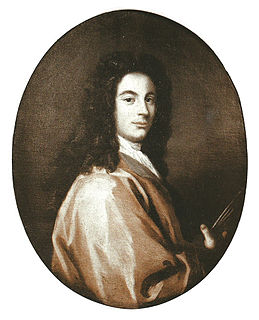
Antonio Balestra was an Italian painter of the Rococo period.
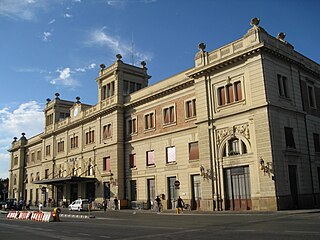
Forlì railway station serves the city and comune of Forlì, in the region of Emilia-Romagna, northern Italy. Opened in 1926, it forms part of the Bologna–Ancona railway.
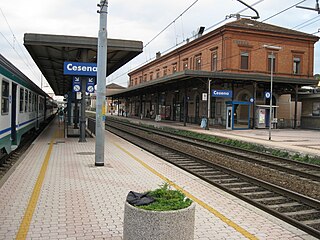
Cesena railway station serves the city and comune of Cesena, in the region of Emilia-Romagna, northern Italy. Opened in 1861, it forms part of the Bologna–Ancona railway.
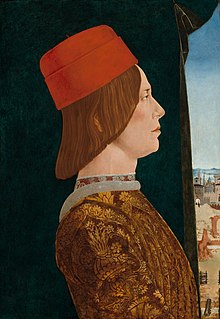
Giovanni II Bentivoglio was an Italian nobleman who ruled as tyrant of Bologna from 1463 until 1506. He had no formal position, but held power as the city's "first citizen." The Bentivoglio family ruled over Bologna from 1443, and repeatedly attempted to consolidate their hold of the Signoria of the city.

Francesco Gonzaga was an Italian bishop and a Cardinal of the Roman Catholic Church during the reigns of Popes Pius II, Paul II and Sixtus IV.

The Battle of Riccardina or Battle of Molinella, fought on July 25, 1467, in Molinella, was one of the most important battles of the 15th century in Italy.

The Bologna–Ancona railway is an Italian railway that connects the city of Bologna with the city of Ancona, passing through the Po Valley to Rimini and along the Adriatic coast for the rest of the line.
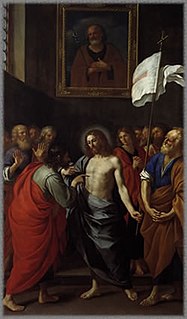
Bartolomeo Gennari was an Italian Renaissance painter.

The Sanctuary of Santa Maria della Pioggia is a small church, located on Via Riva Reno 122, between Galliera road and Riva di Reno road in central Bologna, Italy. It was once the Oratory of San Bartolomeo di Reno.

The Palazzo Malvezzi de' Medici is a Renaissance-style palace located on Via Zamboni #13 in central Bologna, Italy. The palace now houses the offices of the Provincial Administration.
The following is a timeline of the history of the city of Forlì in the Emilia-Romagna region of Italy.

Giovanni Battista Ramenghi was an Italian painter. He is sometimes known as Bagnacavallo junior or Bagnacavallo the Younger to distinguish him from his father Bartolomeo Ramenghi.

Madonna of the Rose is a 1530 oil on panel painting by Parmigianino, now in the Gemäldegalerie in Dresden.
References
- ↑ "BARTOLOMEO GONZAGA". condottieridiventura.it. Retrieved 2 May 2017.
- ↑ Storia delle compagnie di ventura in italia di Ercole Ricotti, Volume 1. p. 207.